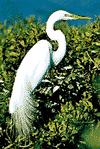- egret
-
/ee"grit, eg"rit, ee gret", ee"gret/, n.1. any of several usually white herons that grow long, graceful plumes during the breeding season, as Egretta garzetta (little egret), of the Old World.2. aigrette.[1400-50; late ME egret(e) < AF egret (cf. MF égreste, AIGRETTE), alter. (with -on exchanged for -et -ET) of dial. OF aigron < Gmc; see HERON]
* * *
Any of several species (mainly in the genus Egretta) of wading birds in the same family (Ardeidae) as herons and bitterns.Egrets live in marshes, lakes, humid forests, and other wetland environments worldwide. They catch and eat small fishes, amphibians, reptiles, mammals, and crustaceans. They nest in trees and bushes or on the ground. Most are white and develop long plumes for the breeding season. The value of plumes as ornamental objects once drove egrets to near-extinction, but changes in fashion and strict conservation measures have allowed their numbers to increase. The great white egret is about 35 in. (90 cm) long; other common species average 20–24 in. (50–60 cm) long. Common egret (Egretta alba)R.F. Head from The National Audubon Society Collection/Photo Researchers
Common egret (Egretta alba)R.F. Head from The National Audubon Society Collection/Photo Researchers* * *
▪ birdany member of several species of herons (family Ardeidae, order Ciconiiformes), especially members of the genus Egretta. Most egrets have white plumage and develop long ornamental nuptial plumes for the breeding season. Their habits are generally like those of other herons, but some perform elaborate mating displays involving the plumes. The name egret, or aigrette, is also used to refer to these plumes; they are highly prized as ornaments in Oriental ceremonial dress and were formerly used in the Western millinery trade. The high prices paid for the plumes, along with the vulnerability of the birds, who nest in large breeding colonies, resulted in the near extinction of egrets because of unscrupulous hunters. Changes in fashion and strict conservation measures have since allowed their numbers to increase.Egrets typically frequent marshes, lakes, humid forests, and other wetland environments. They are wading birds and catch small fishes, amphibians, reptiles, mammals, and crustaceans in shallow waters. They build large, untidy nests in trees and bushes or on the ground.The great white egret, Egretta (sometimes Casmerodius) alba (see photograph—>), of both hemispheres, is about 90 cm (35 inches) long and bears plumes only on the back. The American populations of this bird are sometimes called American, or common, egrets.The cattle egret, Bubulcus (sometimes Ardeola) ibis, spends much of its time on land and associates with domestic and wild grazing animals, feeding on insects that they stir up and sometimes removing ticks from their hides. It is a compactly built heron, 50 cm long, white with yellowish legs and bill and short, fluffy nuptial plumes. It has extended its range from Europe, Africa, and Asia to Australia and the Americas.The little egret (E. garzetta), of the Old World, about 55 cm long, is white with firm plumes on the head and lacy plumes on the back.The reddish egret, Hydranassa (or Dichromanassa) rufescens, of warm coastal regions of North America, has two colour phases: white and dark. The snowy egret, E. (or Leucophoyx) thula, ranging from the United States to Chile and Argentina, is white, about 60 cm long, with filmy recurved plumes on the back and head.* * *
Universalium. 2010.
